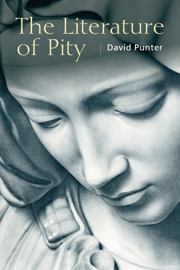Book contents
- Frontmatter
- Contents
- Plates
- Preface
- Acknowledgements
- 1 Distinguishing Pity
- 2 Pity and Terror: The Aristotelian Framework
- 3 Pietà
- 4 Shakespeare on Pity
- 5 The Eighteenth Century
- 6 Blake: ‘Pity would be no more …’
- 7 Aspects of Victoriana
- 8 Chekhov and Brecht: Pity and Self-Pity
- 9 ‘War, and the pity of War’: Wilfred Owen, David Jones, Primo Levi
- 10 Reflections on Algernon Blackwood's Gothic
- 11 Pity's Cold Extremities: Jean Rhys and Stevie Smith
- 12 Reclaiming the Savage Night
- 13 ‘Pity the Poor Immigrant’: Pity, Diaspora, the Colony
- 14 Lyric and Pity
- After Thought: Under the Dome
- Notes
- Bibliography
- Index
3 - Pietà
Published online by Cambridge University Press: 05 September 2014
- Frontmatter
- Contents
- Plates
- Preface
- Acknowledgements
- 1 Distinguishing Pity
- 2 Pity and Terror: The Aristotelian Framework
- 3 Pietà
- 4 Shakespeare on Pity
- 5 The Eighteenth Century
- 6 Blake: ‘Pity would be no more …’
- 7 Aspects of Victoriana
- 8 Chekhov and Brecht: Pity and Self-Pity
- 9 ‘War, and the pity of War’: Wilfred Owen, David Jones, Primo Levi
- 10 Reflections on Algernon Blackwood's Gothic
- 11 Pity's Cold Extremities: Jean Rhys and Stevie Smith
- 12 Reclaiming the Savage Night
- 13 ‘Pity the Poor Immigrant’: Pity, Diaspora, the Colony
- 14 Lyric and Pity
- After Thought: Under the Dome
- Notes
- Bibliography
- Index
Summary
The terms ‘pity’ and ‘piety’ have long become intertwined, probably through their Latin and Italian roots; but it is in fact pity that is conjured in the famous images of the pietà which we have inherited from medieval and Renaissance art, perhaps especially emblematised in what is regarded as one of Europe's aesthetic masterpieces, Michelangelo's extraordinary sculpture. We are speaking here of the Christian tradition, and of how the notion of pity has become focused on the image of the Virgin Mary cradling the dead body of Jesus in her arms after he has been cut down from the Cross.
But we need to ask more clearly what is at stake here, because in a different vocabulary we would refer to this tradition as a set of works of mourning, picking up for example on the alternative title ‘Lamentation’ attached to so many of these works of art, and a work of mourning which is redoubled. It is redoubled because there is a sense in which we believe that no parent should ever be called upon to mourn the loss of his or her child. This is, always, part of our response to the casualties of conflict: when we mourn we like to emphasise that our mourning is for the ‘innocent’, for those who, for example, have been permitted no knowledge of what the conflict might have been about, for those who have died without meaning, without cause.
- Type
- Chapter
- Information
- The Literature of Pity , pp. 24 - 34Publisher: Edinburgh University PressPrint publication year: 2014



